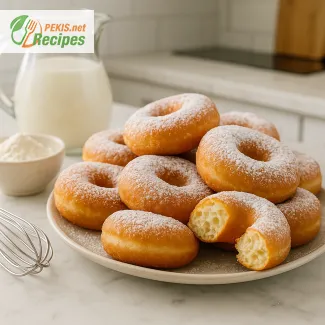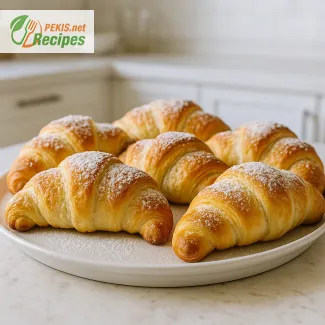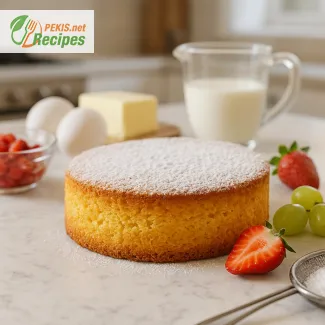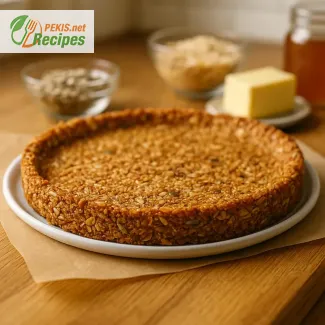Homemade Cinnamon Rolls for Christmas Breakfast serve 12 pieces, with 30 minutes prep, 25 minutes baking, and a total of 115 minutes including rising. Made from fluffy enriched dough, filled with buttery cinnamon sugar and topped with a smooth vanilla glaze, they bring festive warmth to the table. Best enjoyed fresh, they can be stored 2 days at room temperature or frozen up to 2 months. Perfect for a cozy holiday morning, these rolls combine softness, aroma, and indulgence in every bite.
PEKIS – professional chef and recipe developer with over 25 years of experience in baking, specializing in European and international cuisine. For these homemade cinnamon rolls, I’ve drawn on my long practice with enriched doughs and festive pastries, focusing on achieving that soft, pillowy texture and the rich cinnamon swirl that makes Christmas mornings truly special.
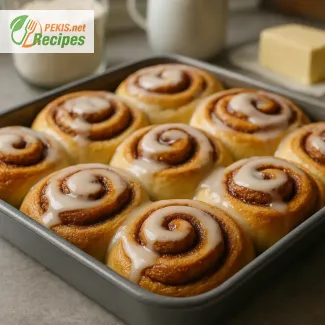
Festive Morning Delight with Cinnamon Rolls
The magic of homemade Christmas breakfast traditions
Warm, fragrant, and irresistibly soft, homemade cinnamon rolls are one of those timeless treats that instantly bring comfort and joy to the holiday table. The swirl of sweet dough layered with buttery filling and a dusting of cinnamon spice makes them a centerpiece for any Christmas breakfast. When paired with a velvety glaze or cream cheese frosting, these golden rolls embody the very essence of festive indulgence, creating an inviting atmosphere that lingers long after the last bite.
The tradition of spiced rolls can be traced back to European baking heritage, where variations like Swedish kanelbullar and German zimtschnecken became symbols of warmth during the cold months. Over time, these recipes traveled and evolved, blending local techniques with cultural rituals. Today, preparing a tray of freshly baked cinnamon rolls for Christmas morning feels like honoring centuries of culinary history while adding a personal family touch.
Characteristics that define the perfect cinnamon roll
The foundation of these rolls is an enriched dough, often made with milk, butter, and eggs to achieve a pillowy texture. Once proofed, the dough becomes a canvas for a cinnamon-sugar filling that melts into delicate layers during baking. The topping, whether a thin glaze or a rich frosting, adds both visual appeal and an indulgent sweetness. Each component plays a role:
- Flour provides structure and elasticity.
- Yeast delivers lift and the signature airy crumb.
- Butter enriches the dough, creating tenderness.
- Cinnamon infuses depth, warmth, and festive aroma.
- Sugar balances spice and enhances caramelization.
Together, these elements create a pastry that is both nostalgic and celebratory, fitting perfectly into holiday mornings where families gather and traditions unfold.
Why you’ll love this recipe
- Soft, fluffy texture with a golden crust.
- Rich cinnamon swirl that tastes unmistakably festive.
- Ideal for sharing at Christmas gatherings.
- Can be prepared in advance for stress-free mornings.
- Customizable with different fillings or toppings.
Creative variations to explore
While the classic version never fails, experimenting with flavors can make your rolls stand out:
- Add orange zest or cardamom to the filling for a refreshing twist.
- Drizzle with maple glaze for a rustic finish.
- Incorporate toasted pecans or walnuts for a nutty crunch.
- Replace frosting with salted caramel sauce for extra indulgence.
- Swirl in chocolate chips for a holiday dessert-style roll.
These creative spins allow the same base dough to transform into entirely new experiences, ensuring that every family member finds their favorite.
Storage and make-ahead guidance
Cinnamon rolls are best enjoyed fresh, but with thoughtful planning they can easily fit into a busy holiday schedule:
- At room temperature: up to 2 days in an airtight container.
- Frozen: up to 2 months when wrapped well.
- Reheating: warm in the oven at 150 °C for 8–10 minutes to restore softness.
Preparing them the evening before and refrigerating overnight allows you to bake them fresh in the morning without the rush, filling your kitchen with the aroma of cinnamon while the gifts are unwrapped.
Enticing details that make this dish stand out
The appeal of homemade cinnamon rolls for Christmas breakfast goes beyond flavor—it’s about the experience. The act of rolling the dough, layering the filling, and cutting perfect spirals becomes a ritual that brings family together in the kitchen. The first bite, still warm and tender, feels like the reward of both patience and anticipation. With their golden layers, fragrant filling, and festive presentation, these rolls are more than just a pastry; they are a culinary tradition that anchors the holiday morning.
- Warm the milk slightly and dissolve the yeast with a teaspoon of sugar. Let it rest for 5–10 minutes until foamy.
- In a large bowl, combine flour, remaining sugar, and salt. Add melted butter, eggs, and the yeast mixture. Knead into a smooth dough.
- Cover and let rise in a warm place for about 60 minutes, or until doubled in size.
- Roll the dough into a rectangle on a floured surface. Spread softened butter evenly, then sprinkle with brown sugar and cinnamon.
- Roll the dough tightly into a log and cut into 12 equal pieces.
- Place rolls in a greased baking pan, leaving space between them. Cover and let rise again for 30–40 minutes.
- Preheat oven to 180 °C (350 °F). Bake rolls for 20–25 minutes until golden brown.
- Mix powdered sugar, milk, and vanilla extract into a glaze. Drizzle over warm rolls before serving.
FAQ questionCan I make the rolls the night before?
Yes. Assemble and slice the dough, nestle the spirals in a pan, cover tightly, and refrigerate 8–16 hours. In the morning, let them proof at room temperature until puffy (about 45–75 minutes), then bake. For longer prep, freeze the shaped rolls up to 2 months, thaw overnight in the fridge, proof, and bake. This “overnight cinnamon rolls” method keeps Christmas morning calm.
FAQ questionWhat flour gives the softest texture?
Use all-purpose flour (about 10–11.5% protein) for pillowy, tender crumb. Bread flour can add chew but may tighten the crumb if over-kneaded, while cake flour lacks structure. Aim for a soft, slightly tacky dough that clears the bowl; this hydration helps those signature layers stay light and fluffy.
FAQ questionHow do I keep the filling from leaking out?
Spread softened butter (not melted) so it grips the sugar and ground cinnamon, leave a thin unbuttered edge to seal, roll tightly, and chill the log 10–15 minutes before slicing. Cut with unflavored dental floss for clean spirals. Nest rolls close so they rise together, which helps retain the buttery cinnamon swirl.
FAQ questionHow warm should the milk be for the yeast?
Target 38–40 °C (100–104 °F). Cooler milk slows fermentation; hotter milk can kill yeast. Bloom 5–10 minutes until foamy. If there’s no activity, the yeast may be inactive—start over to ensure a strong, reliable rise.
FAQ questionHow do I know when they’re perfectly baked?
Look for deep golden tops and set centers. An internal temp of 88–93 °C (190–200 °F) signals doneness for enriched dough. If browning too fast, tent with foil. The center roll should spring back when lightly pressed, and the kitchen should smell intensely of cinnamon-butter.
FAQ questionWhat’s the best way to store and reheat?
Keep at room temperature up to 2 days in an airtight container or freeze up to 2 months (baked or shaped-unbaked). Reheat baked rolls at 150 °C for 8–10 minutes or in the microwave for 10–15 seconds (add a small cup of water to keep them moist). For the freshest finish, glaze after reheating so the topping stays silky.
Freshly baked cinnamon rolls capture the essence of Christmas morning, filling the kitchen with warmth, comfort, and anticipation. Their soft dough, layered with cinnamon-sugar filling, delivers a balance of sweetness and spice that has made them a holiday tradition across cultures. Serving them warm, just out of the oven, creates an unforgettable moment of togetherness.
The combination of fluffy texture, rich aroma, and creamy glaze ensures that these rolls remain a festive centerpiece year after year. Their versatility allows for countless variations, from citrus accents to nutty toppings, making them adaptable to every family’s taste while still honoring the timeless appeal of the classic.
With thoughtful preparation, these cinnamon rolls can be made ahead, stored, or frozen, making holiday mornings more relaxed and joyful. The ability to reheat and enjoy them later means that the tradition extends beyond a single meal, offering comfort well into the season.
Every swirl of butter, sugar, and spice represents more than flavor—it reflects celebration, heritage, and shared experience. Placed at the heart of a Christmas breakfast, they bring people together and create memories that last far longer than the holiday itself.
Allergens present in the recipe
- Gluten (flour)
- Eggs
- Dairy (milk, butter)
Tips for substitutions
- Replace regular flour with gluten-free all-purpose flour to make the recipe gluten-free.
- Substitute dairy milk with oat or almond milk and butter with plant-based margarine for a lactose-free version.
- Use flaxseed meal mixed with water as an alternative to eggs for an egg-free version.
- Vitamin A: 180 µg – supports vision and immune system.
- Vitamin B2 (Riboflavin): 0.2 mg – contributes to energy metabolism.
- Vitamin B12: 0.3 µg – important for nerve function.
- Calcium: 60 mg – supports bone health.
- Iron: 2 mg – essential for oxygen transport.
- Magnesium: 20 mg – important for muscle and nerve function.
- Potassium: 120 mg – helps regulate fluid balance.
- Cinnamon polyphenols: 40 mg – support blood sugar regulation and reduce inflammation.
- Vitamin E: 0.4 mg – protects cells from oxidative stress.
- Beta-carotene: 50 µg – acts as an antioxidant and supports skin health.
